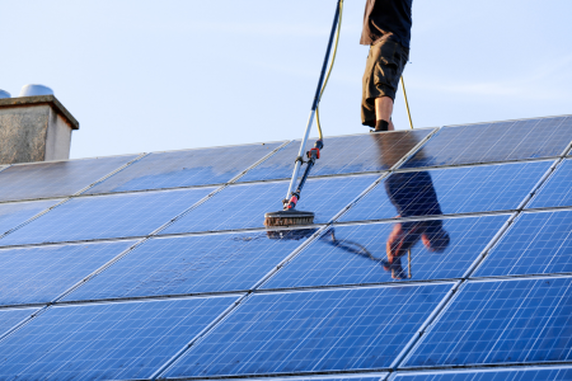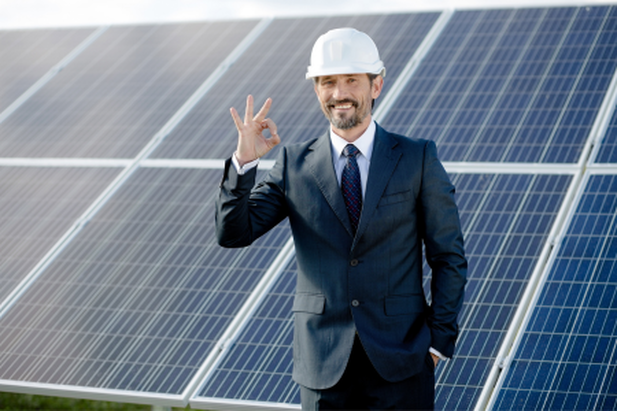|
Solar power is gaining popularity globally as more companies and homeowners realize its benefits. However, some people have solar systems but need help reading solar panel meters. A solar panel meter is a device for measuring the sunlight or solar power in W/m2 units, either via windows to verify its efficiency or during the installation of solar power devices. It indicates pyranometers, which measure the solar radiation flux density or the devices for measuring kWh production from the photovoltaic system. This meter accumulates PV yield production and consumption to analyze or monitor a PV plant's performance. Reading a Solar Panel MeterA solar meter displays an alternate between negative and positive numbers. A positive number denotes a company or household has electricity imported from the national grid. Usually, you can see this on a typical electricity meter without a solar system. A negative number indicates the amount of electricity a company or household has exported from its solar system to the national grid. It shows the amount of electricity a solar system has generated beyond what it consumes or needs. When the negative value is higher than the positive value, a household or property has exported more electric power than it has imported. Thus, the household or property owner can get the local power company refunds. About Solar Power MeasurementsThe solar radiation reaching the absorbent surface signifies the energy output. You can instrumentally measure the solar radiation on the surface of the earth. Precise solar radiation measurements provide crucial background data for solar energy conversion applications. Two instruments help with solar radiation measurement as follows: PyranometerA pyranometer measures the total hemispherical radiation. A pyranometer will measure diffuse radiation if there is a shadow. Most source data is from a pyranometer. Using a pyranometer, you can calculate total irradiance or W/m2 on a horizontal surface. A pyranometer can have photovoltaic detectors and thermocouple indicators. Sensors should be independent of the solar spectrum's wavelength and incidence angle. Also, pyranometers can measure solar radiation for inclined surfaces, which is crucial in determining relevant information. Pyranometers' calibration relies on the inclination angle. Therefore, experimental data is necessary when interpreting measurements. PyrheliometerPyrheliometer measures direct beam radiation within the normal incidence. Different types of pyrheliometers exist. However, the primary or standard instruments are Angstrom compensation and Abbot silver disc pyrheliometer. Kipp and Zonen actinometer and Eppley normal incidence pyrheliometer are typical instruments for practical measurements. Depending on the design of the pyrheliometer, it can measure the sun's beam radiation and a small part of the sky surrounding the sun. According to studies of several pyrheliometer designs, the circumsolar sky's contribution to the beam is insignificant during a sunny day when the skies are clear. Nevertheless, a gloomy day redistributes beam radiation so that the circumsolar sky's contribution to the measurement becomes more significant. ConclusionA solar panel meter is a vital device that measures solar power units. It's bi-directional, meaning it counts the household's solar energy production and export. Upon your new solar panel installation, a solar panel meter can help you reduce the money you spend on electricity. It can help you claim a refund from the national grid or utility company for exporting the excess energy.
Some consider Saskatoon the Paris of Prairies due to its gorgeous brass-colored bridges. This vibrant city is at the heart of Saskatchewan province in Canada. Most people know it for its friendly locals, rich culture, and picturesque settings. It offers various experiences and attractions for visitors. Here are the top attractions to visit in Saskatoon, especially when touring it for the first time. Saskatoon Forestry Farm Park and ZooThis park and zoo started over a century ago as a small tree nursery. However, it's grown into a National Historic Site with crafted gardens, the only accredited zoo in Saskatchewan, and heritage buildings. This attraction is famous for hosting over 90 species of animals and birds in settlements that resemble their natural habitats. They include grey wolves, capuchin monkeys, Madagascar ruffed lemurs, and Chinese red pandas. Besides the birds and animals, the park provides learning programs for adults and kids, making it a famous attraction for family travel. Western Development MuseumThe rich railway roots have enabled Saskatoon to grow into a thriving industrial center. The railway line changed the region's essence in 1908 by bringing European immigrants into the Western prairies. The Western Development Museum has a life-size 1910 Boomtown replica that takes visitors back in time. It has a school, laundromat, church, and feed store with actual artifacts of that time. Also, carriage lines, ancient tractors, and vintage streetcars attract visitors. The museum has a section for scientific and agricultural innovations from Saskatchewan. Visiting this museum enables you to learn more about ancient Saskatchewan. Wanuskewin Heritage ParkWanuskewin Heritage Park is a proposed UNESCO World Heritage Site. It's a historical and non-profit cultural center aiming to provide better knowledge of the region's indigenous inhabitants. Wanuskewin means "living together in harmony." The park's ground has the longest-running archaeological dig in the country. Archaeologists discover 6,000-year-old relics daily at this site. The medicine wheel, a 1,500-year-old artifact, is among the archaeological finds of this site. The Ukrainian Museum of CanadaThe Ukrainian Museum of Canada is in central Saskatoon. It honors and preserves the unique culture and traditions of the Ukrainian Canadians. Some artifacts in this museum include textiles, artwork, wood carvings, weavings, and beautiful easter eggs or pysanky. It is a tribute to around 170,000 families that relocated to Saskatchewan, and it has existed since 1936. It has three galleries, and it documents the arduous journey of the immigrants, including their tribulations and trials. Saskatoon Farmers MarketYour visit to this place will only be complete if you visit the Saskatoon Farmers Market. You'll enjoy a refreshing walk from downtown and along the waterfront to the Riversdale neighbourhood. The outdoor and indoor market is the largest and the oldest in the province. It's the best attraction to visit if you want to enjoy the nourishing food from the farmers in this region. You'll find fresh fruits, vegetables, pickerel fish, spreads, and specialty foods. Also, you can get works from local artisans in permanent and temporary stalls.
These are some popular attractions to visit in Saskatoon. Nevertheless, you'll find more appeals if you have more time during your visit to venture throughout the city. Solar panels provide sustainable energy despite their low maintenance. Regular cleaning is one of the best ways to ensure your solar panels function efficiently. Dirt, grime, and dust accumulate on the solar panels, hindering the photovoltaic cells from absorbing the sun's rays. The panels' efficiency reduces when a layer of grime and debris blocks these cells. Research has shown that accumulating soot, dust, and other particulates reduces solar panels' efficiency by up to 7%. Luckily, you can clean solar panels to remove grime and dust, restoring their maximum efficiency. A Step-by-Step Guide for Cleaning Your Solar PanelsBefore you start cleaning your solar panels:
The best product is a solar panel cleaner, a combination of water and dish soap, and a little vinegar. You may ask your solar panel manufacturer about the best cleaning products, buy them, and follow the manual when using them. Here are the steps for cleaning solar panels. 1. Gather Materials and EquipmentEnsure you have everything necessary for the cleaning project ready. Also, set up an extension ladder, ensuring you can access the solar panels on the roof. Make the cleaning solution you will use in your gallon sprayer. Also, ensure you have a friend or family member to hand you the products and hold the ladder. 2. Turn off Your Solar Panel SystemAvoid cleaning the solar panels while the system is still working. Turning off the power is essential in protecting your system and ensuring safety. 3. Spray Down the Roof and PanelsClimb the ladder to reach the roof while your friend or family member securely holds the extension ladder. Rinse off the top and solar panels with a garden hose and the spray attachment to remove loose dirt and debris. 4. Apply the Cleaning SolutionAfter washing off loose dirt and debris, apply the cleaning solution with the gallon sprayer to a small part of a solar panel. Let the solution cut through the grime and dirt for some minutes. However, avoid leaving it on the solar panels for too long so it doesn't fry. 5. Wipe Down the Cleaning SolutionWipe down the solution using a sponge or soft brush. Avoid leaning over the panels and stand on the extension ladder instead. If necessary, you can wrap a clean towel around the squeegee on an extension pole. 6. Do the Same on Small SegmentsFollow the above steps to apply the cleaning solution and wipe it off in small segments until you clean all solar panels. 7. Rinse All PanelsOnce you've applied and wiped off the cleaning solution in all solar panels, use the hose and spray attachment to clean them off. Finally, dry your solar panels with the squeegee before turning your solar system on.
The best time to clean solar panels is when outdoor temperatures are cool. Avoid washing your solar panels when the sunlight is harsh because you can damage them. Please call Saskatoon Solar for professional assistance if you're uncomfortable cleaning your solar panels. At Saskatoon Solar, our customers ask many questions about solar power. Here are some of the frequently asked questions about solar energy. How Does Solar Power Work?When sunlight hits the solar panels, it triggers a chemical reaction that generates a Direct Current power. This power flows to the inverter, transforming it into an Alternating Current power. This conversion is vital because your home and the electric grid run on AC power. From there, the power flows into your home to run appliances and provide lighting or to the power electric grid. Also, you can divert solar panel energy to a battery and store it if you have an excess supply. A battery operates as a DC power source. What Are the Benefits of Solar Power?Solar energy system installation can save you money on your monthly electricity bills. Also, you safeguard yourself against increasing or fluctuating electricity rates. The money you'll save by installing a home solar energy system depends on the local solar policies and utility rates. Nevertheless, installing a solar power system is a wise investment, no matter where you live. Will My Solar Power System Generate Electricity on a Rainy or Cloudy Day?Yes. Solar panels don't generate electricity at night. However, they will produce electricity on a rainy or cloudy day. But they will generate more electricity on sunny days. For solar panels to produce electricity, they require direct sunlight. Therefore, they create more electricity when more sun hits them. But they will still produce electricity even if it's only bright sunny some hours during the day. How Does Installing a Solar Power System Benefit the Environment?Besides the financial benefits, solar power systems benefit the environment. Any renewable energy source has numerous health and environmental benefits. Solar power system installation reduces greenhouse gas emissions, enabling you to participate in reducing climate change. Also, solar energy has fewer air pollutants, such as particulate matter and sulfur dioxide, which has numerous health problems. What is the Cost of Solar Panels?Solar power price has dropped significantly over the last decade. However, the cost of solar panels depends on various factors, including size, brand, and type. Please get in touch with us to get an estimate for your solar panels. Our experts can also guide you to install solar panels to produce the necessary power for your home or farm. How Does Roof Orientation Affect My Solar Power System?Roof orientation influences your solar panels' direction, which affects the amount of electricity they produce. Northerly orientation is usually the best. However, a professional solar installer will consider your roof orientation to place the panels in their best locations and maximize electric production. Should I Clean Solar Panels After Installation?Most solar panels are self-cleaning. When it rains, surface runoff will drain dust and debris away. However, your solar panels might collect debris, dust, and bird droppings if it doesn't rain for an extended period, reducing the amount of electricity they produce. Therefore, checking and cleaning your solar panels might be necessary. Use a soft cloth and a horse to clean your solar panels. Can Solar Panels Increase My Home's Value?Yes. Solar panel installation increases a property's value. Most property buyers prefer homes with solar power systems because they lower monthly electricity bills. Moreover, they avoid the cost of installing solar panels upon moving into residences with solar power systems. Can I Get Free Solar Panels?Nothing is free in life. However, you can lower the cost of installing solar panels by exploiting federal or state government tax incentives. Please research the available tax incentive programs to determine what can work best for you.
Many property owners approach us asking, how many solar panels do I need for my home? Determining the correct number of quality solar panels to install enables you to ensure you’re paying for the amount of electricity your property needs. If you install fewer solar panels, your systems won’t meet your household’s energy requirements. However, installing more solar panels than necessary creates an oversized system, prompting you to give away electricity. The number of solar panels that your business, farm, or home needs to create an ideal size system depends on the tilt or angle of the panels, the direction the panels will face, and the amount of electricity your property needs per year. Experts recommend 1,000W of solar power for 1,1000kWh of electricity usage. Ideal azimuths and steeper tilts produce more solar energy per panel. So, the rough 1,100kW or kWh can fluctuate by + or – 15%, depending on the property. How Many Solar Panels Do I Need in Saskatoon? - Key DeterminantsThe amount of electricity your home, farm, or business consumes and the amount of sunshine your property receives per day should determine the number of solar panels you install. For instance, a 5-kW solar energy system produces an average of 700 kWh per month within central Saskatchewan. Using these figures, you can calculate the number of solar panels to install on your property depending on the amount of electricity your farm, household, or business consumes per year. Our experts at Saskatoon Solar can help you calculate the number of solar panels to install to ensure your property gets sufficient power. Considering factors that affect solar panels performance is crucial. For instance, snow can solar panels lose 5 to 10% of energy every year due to snow. Therefore, ensure the solar panel installers account for snow coverage when sizing your business or home’s solar power system to ensure you get 100% power supply even when it snows. Saving On Your Solar PanelsWorking with reputable installers is the best way to determine the number of solar panels to install. However, you must pick experts who will help you save on your solar panel installation. When you hire Saskatoon Solar, we help you take advantage of the available incentives and rebates. These include the following: Net Metering ProgramIf you qualify for this program, you can sell your unused or excess solar electricity to a local retailer at $0.075 per kWh. This will give you credit that will roll over to the next month and apply to your electricity charges. Commercial Tax IncentiveYou can get an accelerated capital cost allowance from the federal government for your commercial renewable energy system if it’s under class 43.1 and 43.2 of the Income Tax Regulation. With this program, you may write off 100% of an asset within a year of its purchase. Power Generation Partner ProgramUsing this program, you can install a solar system and connect it to the SaskPower grid to sell electricity at a pre-determined rate. This incentive program accepts applicants once annually depending on proximity to high-priority power supply lines. Saskatoon Solar can help you determine the number of solar panels to install on your residential or commercial property to ensure an uninterrupted green energy supply. Please contact us to get a more accurate figure!
|
AuthorSaskatoon Solar Archives
December 2023
Categories |
Saskatoon Solar
|
|




 RSS Feed
RSS Feed